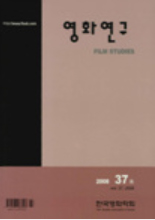- 영문명
- A Study of the Masala Film of India: Analyzed Through a Reading of Dancing Muthu
- 발행기관
- 한국영화학회
- 저자명
- 민병록
- 간행물 정보
- 『영화연구』제37호, 143~173쪽, 전체 31쪽
- 주제분류
- 예술체육 > 예술일반
- 파일형태
- 발행일자
- 2008.09.30
6,520원
구매일시로부터 72시간 이내에 다운로드 가능합니다.
이 학술논문 정보는 (주)교보문고와 각 발행기관 사이에 저작물 이용 계약이 체결된 것으로, 교보문고를 통해 제공되고 있습니다.

국문 초록
영문 초록
In present study, features of the motion picture Masala is analyzed through a reading of Dancing Muthu. First, the foundation for Masala as a movie can be found within the film history of Tamil, Southern India. The first Indian talkie movie is Alam Ara of Bombay, directed by Ardeshir Irani. In the text of this movie, 10 songs are inserted in the Hindi language, reenforced by copious dancing. This is an influence by the traditional South Indian theatre, in which acting, music, and dance are all combined into one. Indian films which have developed from traditional Indian theatres have become musicals. Moreover, this film is advertised as featuring 'everyone talking, singing, and dancing,' which is nothing other than the most important characteristic in modern Indian films. The reason for its success lies in its richness of contents, featuring singing, dancing, and many popular songs as a part of everyday lives in the traditional Indian folk culture, which was able to absorb even the audience from other language areas. Second, the principles for features of traditional theatre in India is found in Natya Shastra (a text for dance, theatre, and music). This book is said to have been written by guru Barata and is acclaimed as the best commentary on Indian Arts known today. In fact, traditional dancing in India, which originates from Southern India, is called Bharata Natyam, named after the title of this book and its author. Natya Shastra has been compiled around 2 A D and is often nicknamed the “Fifth Veda.” The book teaches that all types of art were created by God and were first used for God's own enjoyment. But then they were handed down to entertain all mankind, including the lowly Sudra. The Sudras were even permitted to dance, who were normally forbidden to even hear or recite Veda literature. This allowed them to approach God through their bodily gestures and devotional singing. Natya designates both 'dance' and 'theatre' in Sanskrit language. In fact, most traditional Indian classical dancing employ elaborate 'hand gestures' and 'body movements' as if they would use language, This is a highly stylized theatrical representation, designed to deliver traditional epic tales. Among such bodily language, Natya Shastra provides 36 detailed instructions for moving one's eyes, eye-lids, and brows, and no less than 22 types of descriptions for head and neck postures. With time these have haven been expanded into more than several hundred types. This implies that acquiring skills in traditional Indian dancing requires many years of practice. Like in western ballet, many young and talented Indians today are continuously willing to learn their traditional dance. These young people usually have jobs related to singing, dancing, and acting, and are in fact the very providers of entertainment for the entire nation. They would usually perform in the middle of the night, out in the fields and some of the exceptionally accomplished men and women would be allowed to perform in court. Third, the techniques for emotional and facial expression have roots in the numerous Rasas and Bhavas found in Indian arts tradition. Natya Shastra lists four basic rasas; love, heroism, passion, and despise. There are than further divided into 9 important types of rasas; love, courage, joy, hate, rage, compassion, fear, alarm, and spiritual peace. Each rasa incorporates a number of Bhavas. A Bhava is expressed in various ways according to the time of day, state of health, climate, and other factors in life. The number of Bhavas in a rasa may be as little as three to as many as 49. Meena, who took the role of Ganga in the film, states in an interview that an Indian actor can not perform the multiple facial expressions required in a movie without acquiring fundamental skills in traditional rasas. Fourth is class distinction by the Caste system. According to Caste, Brahman are poets and priests, Kshatrya, the royal family, Bysha, the merchants and farme
목차
1. 들어가는 말
2. 남인도의 타밀(Tamil)영화
3. 〈춤추는 무뚜〉 분석
4. 전통 연극 나티야 샤스트라(Natya Shastra)
5. 인도 예술의 다양한 라사(Rasa)와 바바(Bhava)
6. 맺는 말
해당간행물 수록 논문
- 인도 마살라 영화의 특징 분석
- <고려장>과 <나라야마 부시코>(1958, 1982)에 나타난 공동체 및 효(孝)에 대한 비교 분석
- 매체 다원화 시대 다큐멘터리 장르의 경계에 관한 연구
- 사이버소설 각색영화의 스토리텔링과 문화콘텐츠
- 사단법인 한국영화학회 정관 외
- 영화제작에서 가상 세트와 디지털 스튜디오의 기술 변화 연구
- <8과 2분의 1>과 <바톤핑크>의 3막 구조 연구
- 디지털 시대의 문화적 실천과 영화
- 전 지구화의 대중문화, 한류 담론과 한국영화산업의 동아시아 진출
- 우리영화 심의제도에 대한 논의
- <맥베스>의 마녀 장면
- 북한영화의 탄생과 주인규
- 1910년대 전반기 식민지 조선에서의 활동사진에 관한 연구
- 한국영화 산업 클러스터 정책 연구
- <뮈리엘 혹은 회귀의 시간>에 나타난 기억의 연구
- 한국 영화비평의 정치적 무의식에 대한 연구
- 아방가르드 영화의 미학과 유희적 모더니즘
참고문헌
관련논문
예술체육 > 예술일반분야 BEST
- 생성형 AI 도구와 디자이너의 협업 프로세스 개발 - 이미지를 통한 아이디어 확산에서 고해상도 렌더링까지
- 청소년기의 치료레크리에이션 프로그램을 적용한 디지털 디톡스(Digital Detox) 효과성 연구
- ‘일과 삶의 균형(Work-Life Balance)’ 척도 개발을 위한 연구
예술체육 > 예술일반분야 NEW
- Z세대 생활체육 동호인들의 SNS 중독 경향성과 불안정 성인애착이 완벽주의적 자기제시 및 우울에 미치는 영향
- 즐거움과 몰입을 통한 수익성 기대가 NFT 구매 의도에 미치는 매개효과 분석: UTAUT2와 합리적 무관심(RI)을 중심으로
- 생태체험이 청소년의 자연친밀감, 환경태도, 환경행동의도에 미치는 영향
최근 이용한 논문
교보eBook 첫 방문을 환영 합니다!

신규가입 혜택 지급이 완료 되었습니다.
바로 사용 가능한 교보e캐시 1,000원 (유효기간 7일)
지금 바로 교보eBook의 다양한 콘텐츠를 이용해 보세요!



